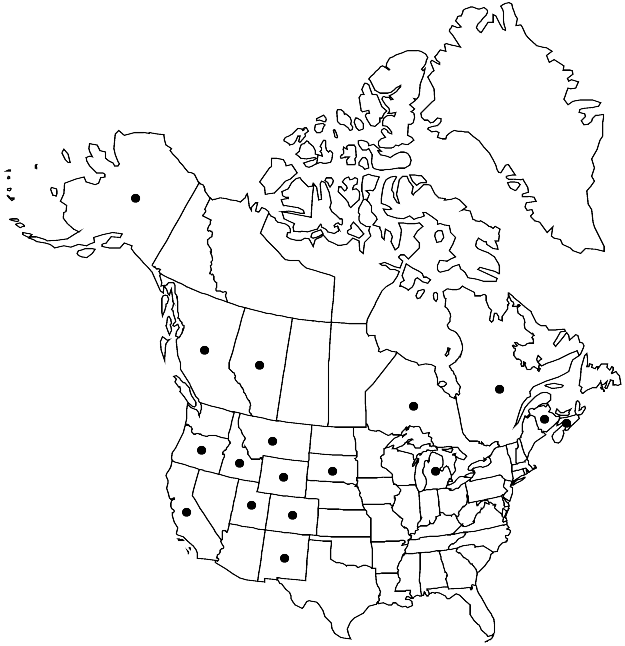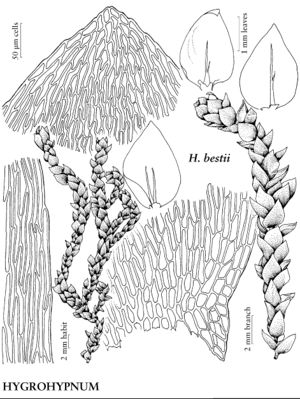Hygrohypnum bestii
Bryologist 4: 12. 1901.
Plants coarse, stiff, rarely soft, olive green, often yellow, or dull yellowish green with golden mottling. Stems to 12 cm, often denuded from base or bearing persistent, shredded leaf bases, rarely leafy throughout, irregularly branched; hyalodermis absent, epidermal cells small, walls thick, similar to subadjacent cortical cells, central stand weak or absent. Leaves often squarrose distally, straight, sometimes secund, contorted when dry, weakly appressed-imbricate or erect when moist, ovate to broadly ovate, concave, (1–)1.5–2.5(–3) × 1–1.5(–2) mm; margins plane to broadly and shallowly concave, entire or uneven apically, rarely denticulate; apex obtuse or somewhat acute; costa usually double, strong from base with one or both branches reaching mid leaf, or single and very strong, reaching beyond mid leaf, often bearing 1–3 forks; alar cells quadrate, short-rectangular, or irregular, region undifferentiated or imprecisely defined; basal laminal cells usually shorter and wider than medial cells, yellowish, yellow-brown with age, pigmentation often creating radiating sunburst effect around costa base, walls usually strongly incrassate; medial cells linear-flexuose to broadly rhombic-flexuose, (40–)60–120(–170) µm; apical cells usually rounded-quadrate to rhombic; marginal cells very long, 60–250 µm. Sexual condition dioicous; perichaetial inner leaves linear-lanceolate, ecostate, costa single to mid leaf, or double and short. Seta red to dark maroon-red, 1.2–2.5 cm. Capsule with endostome cilia 1–3.
Habitat: Irrigated, often silt-covered rock in montane streams
Elevation: moderate to high elevations (1500-3000 m)
Distribution

Alta., B.C., N.B., N.S., Ont., Que., Alaska, Calif., Colo., Idaho, Mich., Mont., N.Mex., Oreg., S.Dak., Utah, Wyo., e Asia (Russian Far East).
Discussion
Hygrohypnum bestii is much confused in North America with H. duriusculum and H. molle; the species is readily distinguished by its diagnostically long marginal laminal cells, to 90 µm or longer. The leaves are decurrent and persistent at the base by incrassate laminal cells and cortical stem cells with yellow-green costae that become brownish with age. The laminal areolation is homogeneous or irregularly interspersed with very wide cells. Long considered a western North American endemic, H. bestii is now known to have remarkable outliers at the Lakehead on Lake Superior, the Upper Peninsula of Michigan, Gaspé Peninsula of Quebec, New Brunswick, and the Cape Breton Highlands of Nova Scotia.
Selected References
None.
